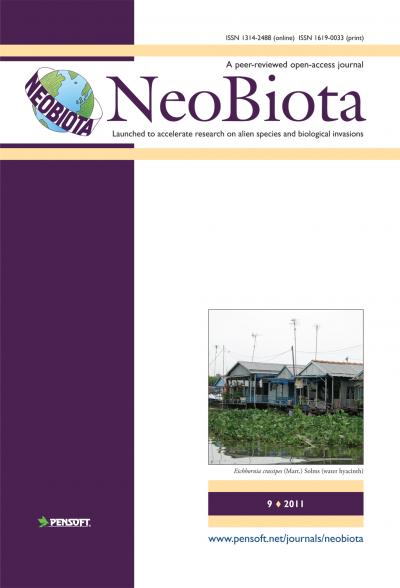Genetic以及对世界各地Carpobrotus杂交复合体的形态学见解
IF 3
2区 环境科学与生态学
Q1 BIODIVERSITY CONSERVATION
引用次数: 0
摘要
The Carpobrotus属N.E.Br。由12至25种组成,其中大部分原产于南非。一些Carpobrotus物种被认为是世界范围内海岸沙丘系统中最具破坏性的入侵物种。在引进地区,这些物种对本地物种构成严重威胁,并对土壤条件和地球化学过程产生重大影响。尽管研究得很好,Carpobrotus的分类仍然存在问题,因为该属包括一个复杂的物种,它们很容易杂交,很难相互区分。为了研究Carpobrotus入侵物种(C. acinaciformis和C. edulis)在其本地和非本地分布范围内的种群遗传结构,我们在阿根廷、意大利、新西兰、葡萄牙、南非、西班牙和美国取样了40个种群。我们利用下一代测序方法开发了分类群特异性微卫星标记,分析了本地和非本地地区的群体遗传结构和杂交发生率。我们确定了三个遗传上不同的集群,它们存在于原生和非原生区域。根据所选择的一组形态学特征,我们没有发现明确的特征来识别分类群。我们的研究结果表明,Carpobrotus物种最可能的全球引种来源是南非的西开普地区和加利福尼亚的海岸线。我们建议全球范围内针对Carpobrotus入侵的管理措施应侧重于防止来自南非东海岸的额外引进,并在南非西开普地区寻找有前景的生物防治剂。本文章由计算机程序翻译,如有差异,请以英文原文为准。
Genetic and morphological insights into the Carpobrotus hybrid complex around the world
The genus Carpobrotus N.E.Br. comprises between 12 and 25 species, most of which are native to South Africa. Some Carpobrotus species are considered among the most damaging invasive species in coastal dune systems worldwide. In their introduced areas, these species represent a serious threat to native species and significantly impact soil conditions and geochemical processes. Despite being well studied, the taxonomy of Carpobrotus remains problematic, as the genus comprises a complex of species that hybridize easily and are difficult to distinguish from each other. To explore the population genetic structure of invasive Carpobrotus species (i.e., C. acinaciformis and C. edulis) across a significant part of their native and non-native ranges, we sampled 40 populations across Argentina, Italy, New Zealand, Portugal, South Africa, Spain, and the USA. We developed taxon-specific microsatellite markers using a Next Generation Sequencing approach to analyze the population genetic structure and incidence of hybridization in native and non-native regions. We identified three genetically distinct clusters, which are present in both the native and non-native regions. Based on a set of selected morphological characteristics, we found no clear features to identify taxa morphologically. Our results suggest that the most probable sources of global introductions of Carpobrotus species are the Western Cape region of South Africa and the coastline of California. We suggest that management actions targeting Carpobrotus invasions globally should focus on preventing additional introductions from the east coast of South Africa, and on searching for prospective biocontrol agents in the Western Cape region of South Africa.
求助全文
通过发布文献求助,成功后即可免费获取论文全文。
去求助
来源期刊

Neobiota
Agricultural and Biological Sciences-Ecology, Evolution, Behavior and Systematics
CiteScore
8.10
自引率
7.80%
发文量
0
审稿时长
6 weeks
期刊介绍:
NeoBiota is a peer-reviewed, open-access, rapid online journal launched to accelerate research on alien species and biological invasions: aquatic and terrestrial, animals, plants, fungi and micro-organisms.
The journal NeoBiota is a continuation of the former NEOBIOTA publication series; for volumes 1-8 see http://www.oekosys.tu-berlin.de/menue/neobiota
All articles are published immediately upon editorial approval. All published papers can be freely copied, downloaded, printed and distributed at no charge for the reader. Authors are thus encouraged to post the pdf files of published papers on their homepages or elsewhere to expedite distribution. There is no charge for color.
 求助内容:
求助内容: 应助结果提醒方式:
应助结果提醒方式:


